|
|
| |
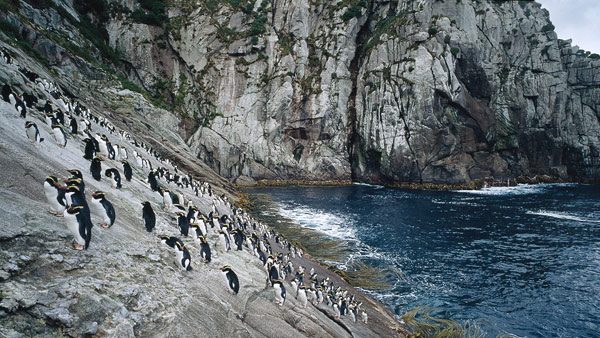 |
| |
| |
NEW ZEALAND ECOLOGY |
| |
|
|
PENGUIN IN PARADISE |
| |
| |
The Snares crested penguin Eudyptes robustus, known also as Snares penguin, belongs to the Spheniscidae family of the Sphenisciformes order. It is only found on North East Island, Broughton Island, and two rock islets in the Western Chain of the Snares Islands group.
It is one of four penguin species that are endemic to New Zealand, and one of the country's six species of breeding penguins.
In a census conducted in 2000 on North East Island, 25,861 pairs of nesting Snares crested penguins were counted. Another 4,000 pairs were estimated to be on Broughton Island.
From a chick count during the breeding seasons in 1983/84 and 1985/86, the breeding population was estimated to be 23,250 pairs, with 19,000 on North East Island, 3,500 on Broughton Island, and 750 on Rima and Toru Islets of the Western Chain.
The 2000 census suggests that the population may not be in decline, however, the two population determinations used different methods so they may not be accurately comparable.
Western Chain birds breed separately, six weeks after birds on the main islands. Their taxonomic status needs to be investigated, as they may be a different species. |
| |
 |
| |
Snares colonies are spread over 3.3 sq.km, the smallest breeding area in the world for any penguin species. |
| |
 |
| |
Snares penguin and Royal penguin Eudyptes schlegeli are the only species of 17 in the world that breed at one location. This vulnerability and restricted range are a serious concern.
Two New Zealand species have smaller populations. Yellow-eyed penguin Megadyptes antipodes that breed on the South Island, and Stewart, Campbell and Auckland Islands has a population of 1500 pairs, and the Fiordland crested penguin has 3000 pairs.
Their full range is unknown, but moulting Snares birds have been seen ashore in the Chatham Islands; on Macquarie, Campbell and Antipodes Islands in the subantarctic; and on South Island and Stewart Island beaches.
The limits of their winter migration are not known, but dispersal appears to be widespread with scarce sightings in Australia and Tasmania, and one sighting in the Falkland Islands (Lamey 1990).
The Snares crested penguin is one of the world's six crested penguin species of the genus Eudyptes. Three of the crested species, and one subspecies are endemic to New Zealand.
The two other crested species, Macaroni penguin E. chrysolophus and Royal penguin E. schlegeli which breed on Macquarie Island in Australian subantarctic territory, feed in New Zealand waters and visit subantarctic islands.
When Reischek visited the subantarctic islands in 1888, he found "... thousands of penguins on the rocks standing like regiments of soldiers ... some disease was amongst them, thousands were lying rotting among the black sand, and the stench was dreadful ..."
The Snares crested penguin is listed as “vulnerable” on the 2006 IUCN Red List of Threatened Species, and “range restricted” on the 2005 New Zealand Threat Classification System. |
| |
 |
| |
Below: Snares crested penguin Eudyptes robustus at the shoreline, Snares Islands 1983. Photo Rod Morris, Crown Copyright © Department of Conservation.
 View slideshow of 10 larger images View slideshow of 10 larger images |
| |
|
|
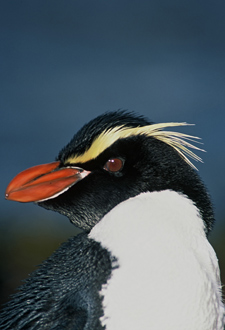 |
| |
| |
Image top: Snares crested penguin climbing a rocky slope at Penguin Slope on North East Island. Crested penguins are adept at climbing steep rock faces.
Copyright © Andris Apse
 View larger images View larger images
Above: Copyright © Tui De Roy, Roving Tortoise Worldwide Nature Photos
 See page on six New Zealand breeding penguin species See page on six New Zealand breeding penguin species |
|
| |
| |
 |
|
| |
| |
The mystery of reduced penguin populations .....
Research in 2001 reported a minimum survival rate of Snares crested penguin of only 15 percent in their first year.
Another study in 1988 indicated that the rate of annual survival up to 5 years of age was 50 percent. The reasons for such low survival are unknown.
Closely related erect crested penguin Eudyptes sclateri which is endemic to Bounty, Antipodes, and Auckland Islands, have the largest New Zealand crested penguin population of 81,000 pairs.
The other close crested relative, the Fiordland crested penguin Eudyptes pachyrhynchus, found on the Fiordland mainland coast, Stewart Island and islands in the Foveaux Strait, has the second smallest New Zealand penguin population of just 3,000 pairs.
The decline of Fiordland crested penguin, which were once prevalent on the mainland, can be partly attributed to predation by introduced rats, cats and stoats.
However, this is not a reason for erect crested penguin decline, because their two island strongholds are free of terrestrial predators.
The reason for erect crested penguin decline is unknown. The only known predators are marine mammals at sea.
The cause of their decline may be competition with commercial fisheries, or a rise in sea temperature since the 1950s.
The same cause of decline should be considered as a potential threat to Snares penguins. Their breeding habitat is at a similar latitude, and is in the middle of a squid fishery.
|
|
| |
|
| |
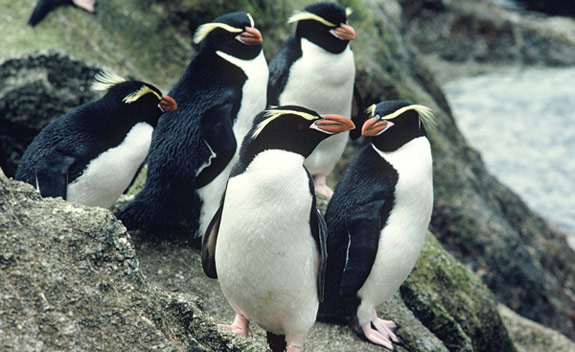 |
| |
| |
| |
Odd crested penguin breeding habits .....
All of the six crested penguin species normally lay two eggs, but what is unusual is that the first egg is always smaller than the other. Even though the second egg is laid four to six days after the first egg, it usually hatches first, and produces a larger chick.
It is normal with most crested penguins that the smaller egg is lost during incubation, or if both eggs hatch, the smaller chick dies before the male stops guarding the chicks.
Crested penguins have been seen deliberately kicking the smaller egg out of the nest. |
| |
 |
| |
Below: Snares crested penguin with chick. Photo Crown Copyright © Department of Conservation
 View slideshow of larger images View slideshow of larger images |
| |
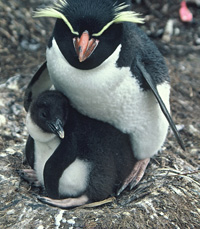 |
| |
|
| |
Some observation has found that the larger chick is favoured with more food, and the smaller chick may even be intentionally starved.
The reason for such strange dimorphic breeding is a mystery. Could the crested penguins have evolved somewhere in between Emperor and King penguins which only lay one egg, and all other penguin species that lay two good eggs?
Snares crested penguin colonies range in size from 10 to 1200 nests. The male returns to the nesting area in August to build a mounded nest bowl from stones, earth, sticks and vegetation. They are very territorial, fighting over nesting areas for about a month.
The female arrives after the male, and the eggs are laid in late September to early October.
Ten days after the eggs are laid, dad breaks his 6-week fast and goes to sea to feed for 12 days while mom incubates. When he returns, she breaks her 39-day fast and goes to sea for 10 days. The chicks hatch after 31-37 days.
The male guards the chicks after they hatch and the female forages every day, returning to feed them but not her mate.
After about 20 days both parents forage and feed the young daily, however, in most cases one chick has died by this stage.
While the parents are at sea during the day, chicks are in a creche, protected by juveniles and non breeding adults.
Fledging occurs after about 75 days when the new members of the family take to the sea to immediately start fending for themselves, preying on krill, squid and small fish. It will grow to a 3.4 kg, 55 cm tall adult, but will not breed until it is 6 years old. |
| |
 |
| |
|
|
|
 |
| |
| |
Snares Islands - the penguin's pristine paradise .....
The Snares Islands are in the Southern Ocean, 105 km southwest of Stewart Island. The land area is 328 hectares and the highest elevation is 152 metres above sea level.
The islands are so perfectly pristine, a visit is a journey back in time before human settlement of New Zealand in the 14th century.
The Snares are principally untouched by human influences, having never been farmed, and with limited sealing in the 19th century.
Native flora is intact, and the ecosystem has not been affected by any introduced animals such as stoats, possums, rats or mice.
Steep cliffs define most of the coastline of the main 280 ha North East Island, except the more gentle slopes of the east coast where the penguins are.
The colonies are on rocky shorelines, and in maritime grassland and tree daisy forest. After the colonies kill off vegetation, the penguins move, allowing the forest to regenerate.
Penguins like to roost two metres above the ground in trees. More than half of North East island is covered with daisy forest, which is predominantly Olearia lyalli with Brachyglottis stewartiae.
The island is of international importance because of its unique ecosystem – it is an island environment with very few plant species, but a highly endemic fauna. |
|
| |
| |
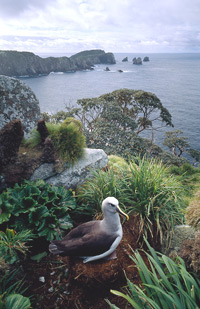 |
| |
| |
Southern Buller's mollymawk Thalassarche bulleri bulleri on the North East Island coast. Copyright © Andris Apse
 View slideshow of larger Snares Islands landscape images View slideshow of larger Snares Islands landscape images |
|
| |
| |
 |
|
| |
| |
The Snares Islands are part of the NZ Subantarctic World Heritage Site, and are a Nature Reserve under the Reserves Act 1977, with landing only by permit. Extreme precautions are taken to prevent non-indigenous plant or animal infestation. Access is only for research, and tourists can only view wildlife by boat.
The Snares Islands are a big part of New Zealand’s status as seabird capital of the world. The islands are the breeding site of two endemic albatross, and the main habitat of Southern Buller's mollymawk Thalassarche bulleri bulleri, supporting a population of 8,877 pairs.
North East Island is the world’s largest breeding location of sooty shearwater Puffinus griseus, with about 2,750,000 pairs. Half of the New Zealand birds, and 28 percent of the world population breed there.
While the terrestrial ecology of the island has the highest possible protection, there is no marine protection around the island, with the exception that fur seals and sea lions are protected under the Marine Mammals Act.
Three native endemic land birds, the Snares Island tit Petroica macrocephala dannefaerdi, Snares Island fernbird Bowdleria punctata caudata, and the Snares Island snipe Coenocorypha aucklandica huegeli are attracted to penguin colonies to feed on white maggots in the mud. This is an example of an interconnected terrestrial and marine ecology.
The penguins are not bothered by sea lions when they are together on land. It is a different story at sea however, where sea lions and leopard seals prey upon penguin. |
|
| |
| |
 |
|
| |
| |
 |
|
|

